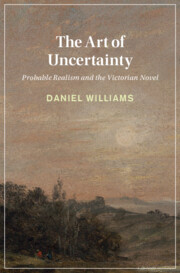
-
Select format
-
- Publisher:
- Cambridge University Press
- Publication date:
- 29 February 2024
- 07 March 2024
- ISBN:
- 9781009436120
- 9781009436113
- Dimensions:
- (229 x 152 mm)
- Weight & Pages:
- 0.66kg, 346 Pages
- Dimensions:
- Weight & Pages:
You may already have access via personal or institutional login- Subjects:
- Literature, English Literature 1830-1900
Book description
The Victorian novel developed unique forms of reasoning under uncertainty-of thinking, judging, and acting in the face of partial knowledge and unclear outcome. George Eliot, Wilkie Collins, William Thackeray, Thomas Hardy, and later Joseph Conrad drew on science, mathematics, philosophy, and the law to articulate a phenomenology of uncertainty against emergent models of prediction and decision-making. In imaginative explorations of unsure reasoning, hesitant judgment, and makeshift action, these novelists cultivated distinctive responses to uncertainty as intellectual concern and cultural disposition, participating in the knowledge work of an era shaped by numerical approaches to the future. Reading for uncertainty yields a rich account of the dynamics of thinking and acting, a fresh understanding of realism as a genre of the probable, and a vision of literary-critical judgment as provisional and open-ended. Daniel Williams spotlights the value of literary art in a present marked by models and technologies of prediction.
Awards
Short-listed, 2025 Book Prize, British Society for Literature and Science
Reviews
‘A strong addition to the series, and it will be stimulating for advanced readers who enjoy studying the evolving form of the novel … Highly recommended.’
S. A. Parker Source: CHOICE
‘This is a forensically detailed and ambitious book, spanning, and often juggling richly, several disciplines at once.’
Alicia Rix Source: The Times Literary Supplement
‘The reader will find exceptionally careful and sensitive analyses of individual novels, as well as suggestive accounts of thematically-related philosophical and psychological problems that concerned the Victorian novelists on whom the book focuses.’
Amanda Auerbach Source: Nineteenth-Century Contexts
Contents
Metrics
Altmetric attention score
Full text views
Full text views help Loading metrics...
Loading metrics...
* Views captured on Cambridge Core between #date#. This data will be updated every 24 hours.
Usage data cannot currently be displayed.
Accessibility standard: Unknown
Why this information is here
This section outlines the accessibility features of this content - including support for screen readers, full keyboard navigation and high-contrast display options. This may not be relevant for you.
Accessibility Information
Accessibility compliance for the PDF of this book is currently unknown and may be updated in the future.


